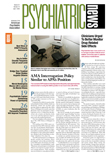Former patients of mental health facilities who were subjected to seclusion and restraint assisted in the development of first-of-their-kind guidelines recently released by the Substance Abuse and Mental Health Services Administration (SAMHSA).
Described as a “training curriculum” for mental health clinicians, the guidelines are designed to teach “prevention strategies” and alternative approaches to avoid and reduce the use of seclusion and restraint.
“A Roadmap to Seclusion- and Restraint-Free Mental Health Services for Persons of All Ages” emphasizes the need to create cultural change within mental health facilities to reduce the use of seclusion and restraint.
“This is the first training curriculum of its sort developed by a federal agency for direct-care staff as a means of reducing or preventing these practices,” Paolo del vecchio, SAMHSA's associate director for consumer affairs, told Psychiatric News.
The curriculum lays out specific strategies, including self-care approaches, peer-provided services, arts programs, and comfort rooms. Other approaches include use of advance directives, mediation, service animals, and better communication approaches.
The curriculum was developed for SAMHSA by the National Association of Consumer/Survivor Mental Health Administrators and combines input from mental health consumers and best practices described by mental health organizations nationwide. Research used to create the curriculum included that of Gayle Bluebird, R.N., who studied the use of comfort rooms as a preventive tool to reduce the need for seclusion and restraint at Atlantic Shores Hospital in Florida.
Final recommendations were pilot tested in two hospitals prior to publication. The pilot programs found that the curriculum contributes to steep reductions in the use of seclusion and restraint, to the extent that one hospital permanently removed the door of its seclusion room, said del vecchio.
State and federal laws and regulations have increasingly aimed to curb the use of seclusion and restraint for mental health care recipients. Among these laws is the Children's Health Act of 2000, which set standards for federally funded health care facilities and nonmedical residential facilities for children.
The curriculum can be ordered in CD-ROM format through SAMHSA's National Mental Health Information Center at<www.mentalhealth.samhsa.gov> or by phone at (800) 789-2647. The curriculum is posted at<www.mentalhealth.samhsa.gov/publications/allpubs/sma064055/>.▪
